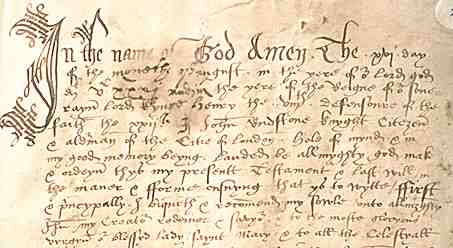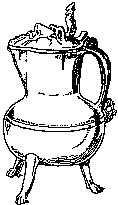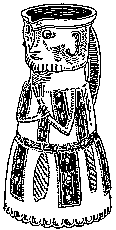





If you are looking at this page without frames, there is more information about medieval writing to be found by going to the home page (framed) or the site map (no frames).
| Wills and Inventories (2) | ||
| Earlier wills, or the wills of ecclesiastical personages, were likely to be in Latin. Over time there was a movement towards the vernacular, so that there is a body of material in English and other vernacular languages for the later middle ages and beyond. | ||
 |
||
| A tantalising snippet of a will of 1484 in the German language, of one Anton Tucher, burgher of Nuremberg, from the private collection of Rob Schäfer. (Image © Rob Schäfer.) | ||
| The above sample represents the will of a significant individual in the town of Nuremburg, and is authenticated by no lesser personage than the hereditary Marshal of the Holy Roman Empire. It is in the German language, although the spelling and grammar are a bit unfamiliar. | ||
| The process of proving a will could involve a combination of written and oral testimony. In the example above, citizens are called to bear witness to the content of the document. The example below is a snippet from what is called a nuncupative will, where an individual has made a written declaration of the intentions of the testator, who had not provided a written will, having died shortly after making an oral declaration of his intentions. | ||
 |
||
| A little sample from the top left hand corner of a declaration by Thomas Bolour of the nuncupative will of Richard Seyntbarbe (British Library, Harley Charter 83 D. 32). (From The New Palaeographical Society 1912) | ||
| The above example begins in the form of an oral declaration, Be hyt knowyn to al. The snippet shown has the name of the oral testator Richard Seyntbarbe and a reference to the manor of Brent Seyntbarbe. | ||
| In the later middle ages and Tudor period, wills could be accompanied by an inventory of all the belongings of the testator. These provide a geat deal of information, and entertainment, for those of us who are fascinated by what stuff people had, and what they valued. | ||
 |
||
| Above, the beginning of the will of Sir John Rudston, alderman of London, who died in 1531. Below, a few random lines from the associated inventory. From a private collection. | ||
 |
||
| The above example is from an extensive document which enumerates in great detail the entire contents of the house of a significant man of affairs in 16th century London. Notable among his belongings are great numbers of items for entertaining, such as cups, plates and table linen. The small segment above, from the hall, indicates tapestry cushions with red roses and stuffed with feathers, and Turkey carpets all over the place. | ||
 |
From the perspective of our consumer age, it is intriguing just to see the kind of valuation that was placed on what we would regard as everyday things. Jugs, plates and cooking pots are carefully enumerated. Embroidered or woven textile items are described in intricate detail, and a beautiful bed coverlet was an item worthy to bequeath. Fine items of clothing are described and apportioned to appropriate family members. Specific items would be donated to charitable causes, for the benefit of the soul of the deceased. |  |
| Despite their formulaic nature, these documents, of all those produced in the middle ages, seem to provide the closest glimpse of the individual. | ||
|
|
||
|
|
||
|
If you are looking at this page without frames, there is more information about medieval writing to be found by going to the home page (framed) or the site map (no frames). |
||